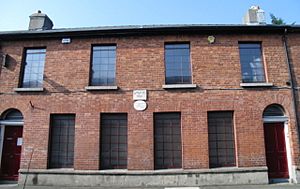Irish Jewish Museum facts for kids
| Músaem Giúdach na hÉireann | |

Wall plaques at the Irish Jewish Museum. The inscription was intended to read as בּית המדרש הגדול (Bet HaMidrash HaGadol), Hebrew for "Great House of Learning"
|
|
| Lua error in Module:Location_map at line 420: attempt to index field 'wikibase' (a nil value). | |
| Established | 20 June 1985 |
|---|---|
| Location | 3 Walworth Road, Portobello, Dublin, Ireland |
| Type | Jewish museum |
| Public transit access | Harcourt Luas stop (Green Line) South Circular Road (Victoria St) bus stop |
The Irish Jewish Museum (in Irish, Músaem Giúdach na hÉireann) is a special place in Dublin, Ireland. It is a small museum that tells the story of the Irish Jewish community. The museum is located in an area called Portobello, which used to have many Jewish families.
The museum first opened its doors in June 1985. Chaim Herzog, who was the president of Israel at the time, officially opened it. He was actually born in Ireland! The museum is set up in what used to be a Synagogue (a Jewish house of worship). This synagogue was built in 1917 inside two houses joined together on Walworth Road. The Portobello area was once a lively Jewish neighborhood. However, many people, including Jewish families, moved away from Ireland in the 1950s. Because of this, Dublin's main synagogue moved to Terenure. The original synagogue building is still kept safe at the museum. You can see old items there, and the museum also has records that can help people trace their family history.
What You Can See at the Museum
The museum has a large collection of items that show the history of Jewish communities in Ireland. These items tell about their lives and how they helped shape Ireland today. The collection covers the last 150 years. It includes stories from Jewish communities in cities like Dublin, Belfast, Cork, Derry, Drogheda, Limerick, and Waterford.
The museum is set up in different sections. When you first enter and walk through the hallways, you will see many photographs, paintings, and old documents. The main floor shows what daily life was like for the Jewish community. This includes their businesses and social activities. There is also a special kitchen display. It shows how a Jewish home might have looked during a Sabbath or holiday meal in the late 1800s or early 1900s.
Upstairs, you can see the original Synagogue. It still has all its special religious items. There is also a gallery named after Harold Smerling, which displays more Jewish religious objects.
Support for the Museum
In 2005, the museum faced some challenges. People showed their support for the museum and the Jewish community. For example, Dermot Ahern, who was Ireland's Minister for Foreign Affairs, visited the museum. He wanted to show that the government supported them. This act of support was also praised by Silvan Shalom, who was Israel's Foreign Minister.
Plans for the Future
In 2012, the museum started a plan to grow and improve its site. This project was supported by the Office of Public Works. In December 2013, a planning board called An Bord Pleanála approved the plans. The idea was to expand the museum and make it even better.
The plans included building new parts and changing some existing structures. The goal was to create an exciting new space for the museum. Enda Kenny, who was the Taoiseach (Ireland's Prime Minister) at the time, supported the plan. He said it was a great project for improving the city. Some local people and architects had different ideas about the plans. They wanted to make sure the original synagogue building was preserved.
See also
- History of the Jews in Ireland


